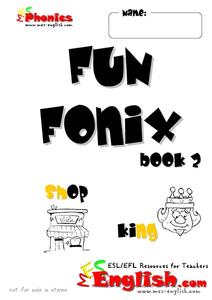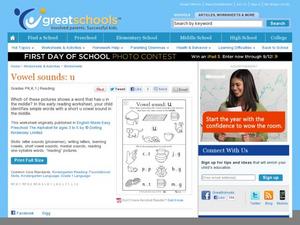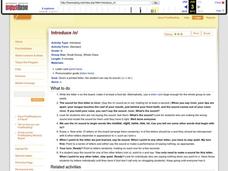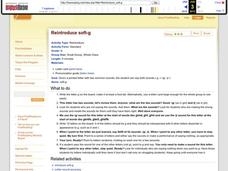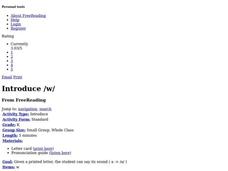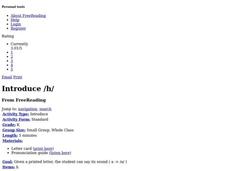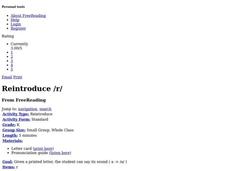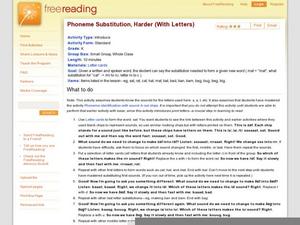Fun Fonix.com
Fun Fonix
Who says you can't have fun while learning to read? This collection of matching, tracing, and spelling worksheets engages beginning readers as they develop an understanding of consonant digraphs.
Florida Center for Reading Research
Fluency, Letter-Sound Correspondence, Make a Match
An activity tests the fluency skills of young readers. Scholars match initial sound cards to letter cards. Pairs take turns and work to locate the most matches before the timer goes off. The activity ends with a peer evaluation.
Ken Baker
Phonemic Alliteration Lesson Plan
Old MacDonald had a ... dragon? A shared reading of this funny take on the classic children's song engages beginning readers as they learn about phonemes and alliteration.
Curated OER
Play I Spy
If you're looking for a fun way to practice initial phonemes with emerging readers, look no further! They examine a farm scene to find things that begin with f, h, or g, writing the total number they found in a box beside...
Curated OER
Practicing Letters i and j
Become acquainted with the lowercase letters i and j and the many words that begin with them. First, printers follow guiding arrows to trace each letter, writing several on their own. Next, they connect the letters to...
Curated OER
Vowel Sound: u
Which of these have /u/ as a middle sound? There are images of seven CVC words surrounding the letter u here, and scholars draw lines from the letter to words with the same middle phoneme. Be sure they know what these images are...
Curated OER
Introduce /y/
As you come to an end in your alphabet study, use these strategies to examine the letter y. Scholars examine the letter shape and listen to you pronounce the /y/ sound. Use these tips to explain how you do it as they try. Can they...
Curated OER
Introduce /n/
What is this letter? Once your class is ready to explore the letter n, use these strategies to combine word examples, pronunciation, and letter recognition. First, can they identify the letter? Make the /n/ sound, explaining...
Curated OER
Introduce /j/
Learn the ins and outs of the letter j using these strategies combining pronunciation, recognition, letter sound, and word examples. Scholars examine the letter shape and listen to you pronounce the /j/ sound. Use these tips to...
Curated OER
Reintroduce Soft-g
Do your scholars know that the letter g sometimes steals the j phoneme? Explore the letter g using these strategies combining pronunciation, recognition, letter sound, and word examples. Scholars examine the letter...
Curated OER
Introduce /w/
Get to know the ins and outs of the letter w using these strategies combining pronunciation, recognition, letter sound, and word examples. Scholars examine the letter shape and listen to you pronounce the /w/ sound. Use these tips...
Curated OER
Introduce /h/
Explore the letter h using these strategies combining pronunciation, recognition, letter sound, and word examples. Scholars examine the letter shape and listen to you pronounce the /h/ sound. As you explain how this sound is...
Curated OER
Reintroduce /r/
The /r/ sound can be a difficult one, but scholars use some helpful tips to get it right. After examining the letter shape they listen to you pronounce this phoneme and describe what you are doing to create the sound. They try on their...
Curated OER
Reintroduce /b/
Combine letter sounds, pronunciation, recognition, and word examples in one exercise by following these strategies. Scholars examine the letter b and identify it if they can. As they listen to you make the /b/ sound, youngsters try...
Curated OER
O
As part of a series of alphabet worksheets, learners focus on the letters p and o. They begin by tracing the lowercase letters, using the space to print a few on their own. Next, scholars connect the letter to images that begin...
Curated OER
Introduce First Sound Segmenting
Mico is back, and he's ready to test your scholars in initial sounds in single-syllable words. Using a puppet and the picture cards provided (these are great and in full-color), play a game with pre-readers. Hold up three picture cards...
Curated OER
Phoneme Segmenting Accuracy
Take your kindergartners on a journey to the mythical planet Paz where residents segment words into phonemes, touching parts of their arm with each sound. This physical response to phoneme segmenting will appeal to your physical learners...
Curated OER
Phoneme Substitution, Harder (With Letters)
Emergent readers create new words by changing a phoneme, using sets of letter cards to spell out each CVC word. They begin by substituting initial sounds, then final sounds, and lastly the middle vowel. Help them sound out each word,...
Curated OER
Practicing Letters C and D
The lowercase letter c and d are highlighted in this two-part worksheet. Kids complete the top half by tracing then printing the letter c and locating images that begin with the /c/ sound. Part two requires them to trace then write the...
Curated OER
Practicing Letters W and X
Match initial phonemes to practice recognizing the sounds made by the letters w and x. Early readers circle all of the objects that begin with either an x or a w, then trace each letter several times. Try a fun variation by having...
Curated OER
Odd One Out
Letters q-z are the topic of the worksheet. Learners circle the picture in each row that does not make the initial letter sound indicated. They then fill in the letter that is missing from the beginning or ending of four words.
Curated OER
What's the First Letter? (A to H)
Here are eight words, and each of them is missing a letter. Not just any letter but the first letter. Oh my! Put your phonics masters to work and have them determine which of the eight letters (a-h) completes each word.
Curated OER
Phonics: Beginning and Ending Sounds
What does the word door start with? Little ones will look at each of the eight images, say them, then fill in the initial or final phoneme that is missing. Afterward, they play an independent game where they think of other words that...
Florida Center for Reading Research
Phonological Awareness: Phoneme Manipulating, What's Left?
Scholars subtract initial phonemes from given picture word cards to create new words. Feet becomes eat, and shelf becomes elf.


